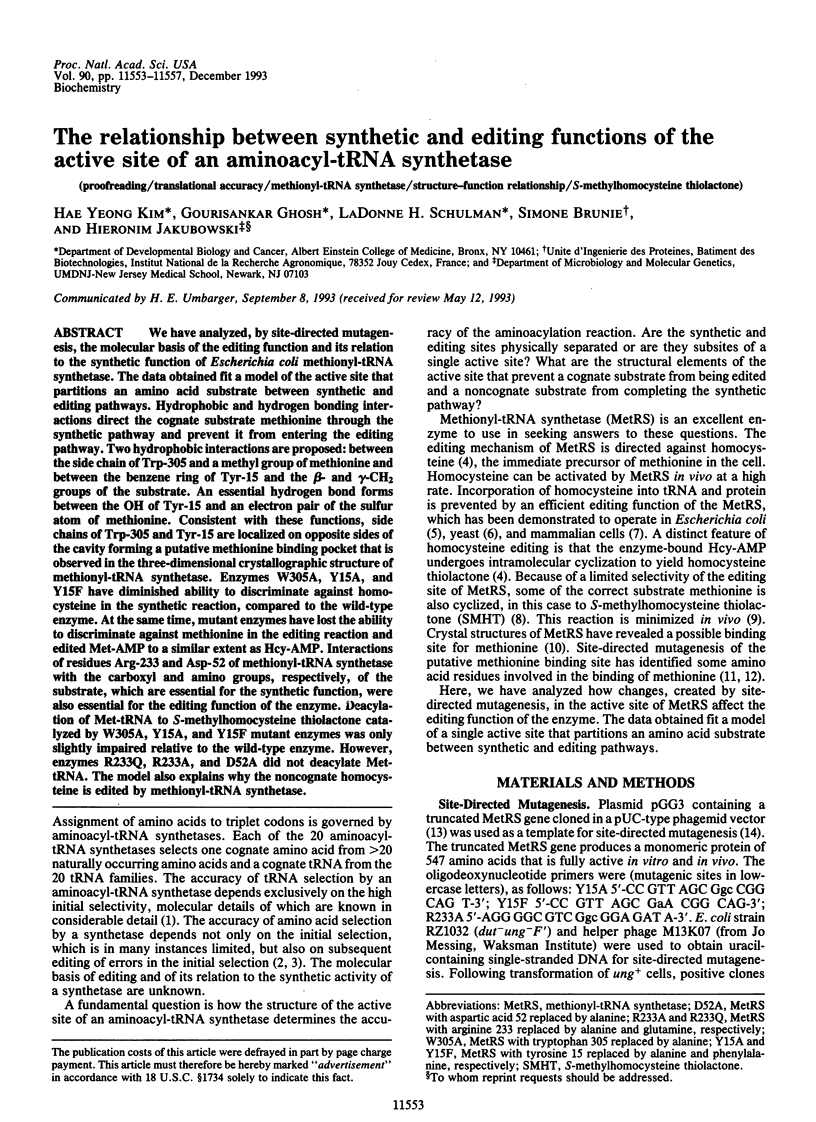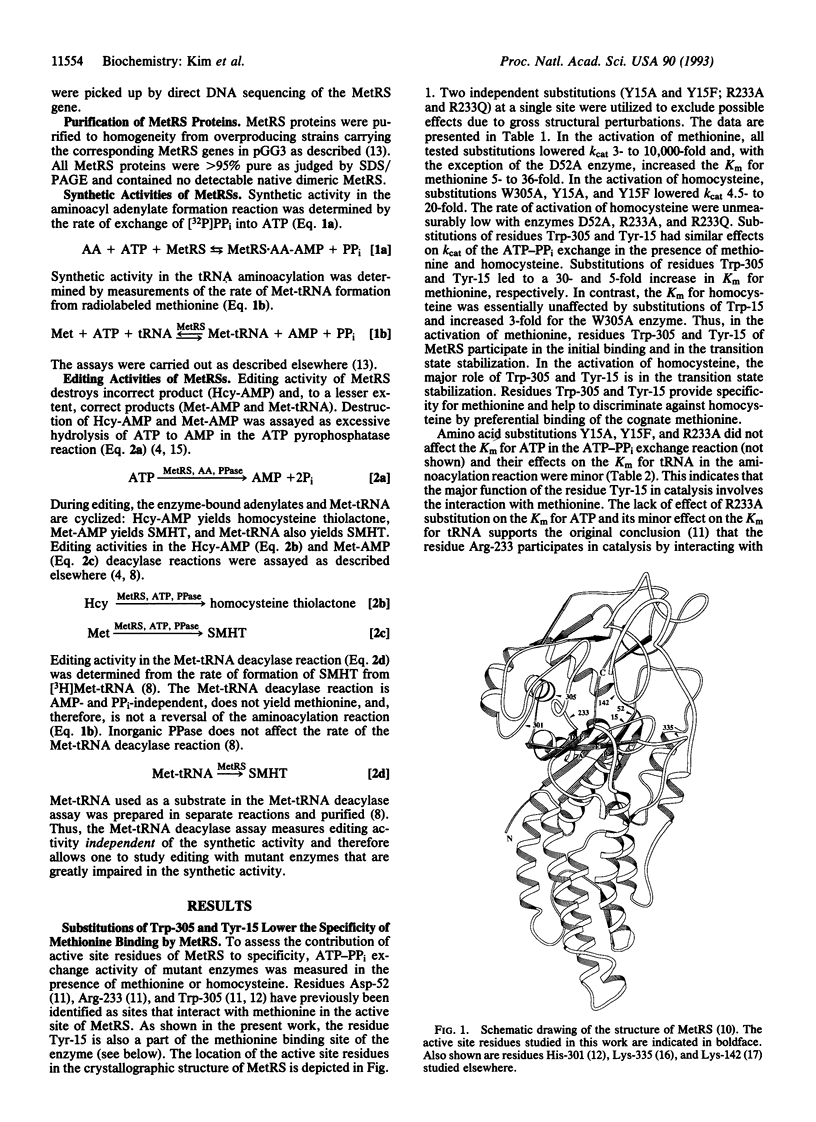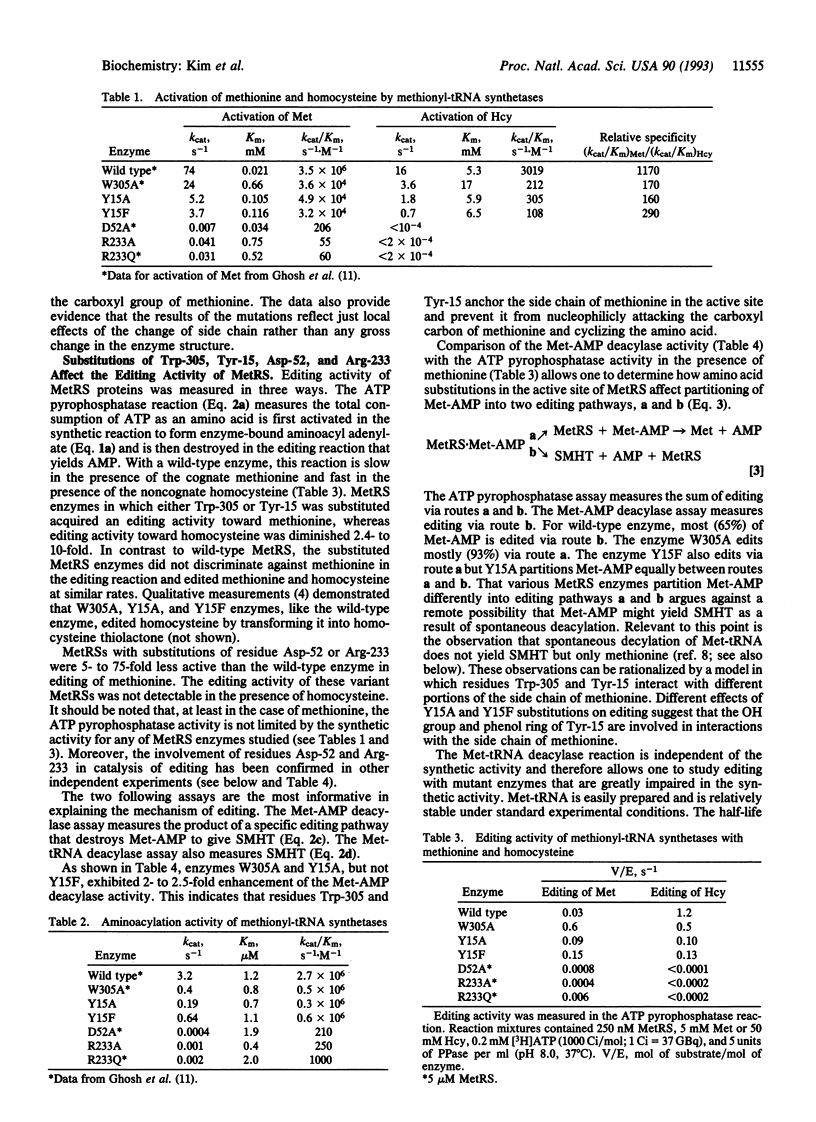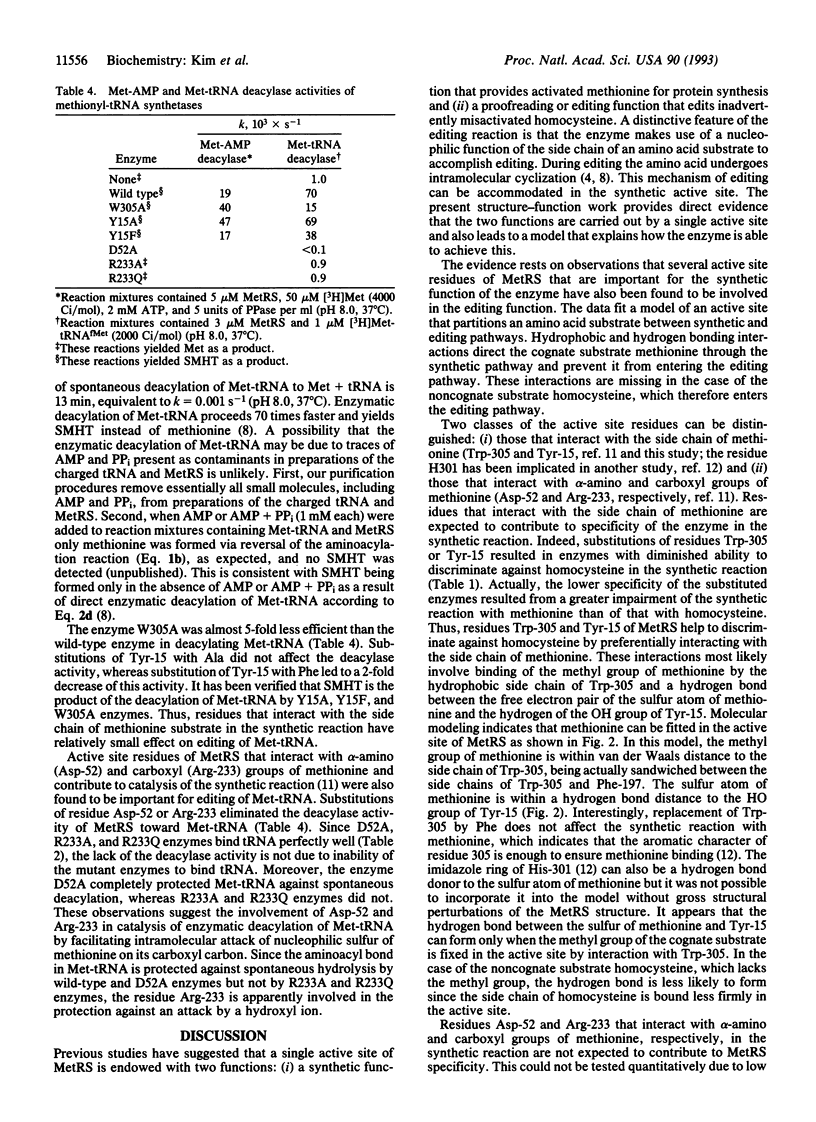Abstract
We have analyzed, by site-directed mutagenesis, the molecular basis of the editing function and its relation to the synthetic function of Escherichia coli methionyl-tRNA synthetase. The data obtained fit a model of the active site that partitions an amino acid substrate between synthetic and editing pathways. Hydrophobic and hydrogen bonding interactions direct the cognate substrate methionine through the synthetic pathway and prevent it from entering the editing pathway. Two hydrophobic interactions are proposed: between the side chain of Trp-305 and a methyl group of methionine and between the benzene ring of Tyr-15 and the beta- and gamma-CH2 groups of the substrate. An essential hydrogen bond forms between the OH of Tyr-15 and an electron pair of the sulfur atom of methionine. Consistent with these functions, side chains of Trp-305 and Tyr-15 are localized on opposite sides of the cavity forming a putative methionine binding pocket that is observed in the three-dimensional crystallographic structure of methionyl-tRNA synthetase. Enzymes W305A, Y15A, and Y15F have diminished ability to discriminate against homocysteine in the synthetic reaction, compared to the wild-type enzyme. At the same time, mutant enzymes have lost the ability to discriminate against methionine in the editing reaction and edited Met-AMP to a similar extent as Hcy-AMP. Interactions of residues Arg-233 and Asp-52 of methionyl-tRNA synthetase with the carboxyl and amino groups, respectively, of the substrate, which are essential for the synthetic function, were also essential for the editing function of the enzyme. Deacylation of Met-tRNA to S-methylhomocysteine thiolactone catalyzed by W305A, Y15A, and Y15F mutant enzymes was only slightly impaired relative to the wild-type enzyme. However, enzymes R233Q, R233A, and D52A did not deacylate Met-tRNA. The model also explains why the noncognate homocysteine is edited by methionyl-tRNA synthetase.
Full text
PDF




Selected References
These references are in PubMed. This may not be the complete list of references from this article.
- Brunie S., Zelwer C., Risler J. L. Crystallographic study at 2.5 A resolution of the interaction of methionyl-tRNA synthetase from Escherichia coli with ATP. J Mol Biol. 1990 Nov 20;216(2):411–424. doi: 10.1016/S0022-2836(05)80331-6. [DOI] [PubMed] [Google Scholar]
- Fersht A. R., Dingwall C. An editing mechanism for the methionyl-tRNA synthetase in the selection of amino acids in protein synthesis. Biochemistry. 1979 Apr 3;18(7):1250–1256. doi: 10.1021/bi00574a021. [DOI] [PubMed] [Google Scholar]
- Fourmy D., Mechulam Y., Brunie S., Blanquet S., Fayat G. Identification of residues involved in the binding of methionine by Escherichia coli methionyl-tRNA synthetase. FEBS Lett. 1991 Nov 4;292(1-2):259–263. doi: 10.1016/0014-5793(91)80879-8. [DOI] [PubMed] [Google Scholar]
- Ghosh G., Brunie S., Schulman L. H. Transition state stabilization by a phylogenetically conserved tyrosine residue in methionyl-tRNA synthetase. J Biol Chem. 1991 Sep 15;266(26):17136–17141. [PubMed] [Google Scholar]
- Ghosh G., Pelka H., Schulman L. H., Brunie S. Activation of methionine by Escherichia coli methionyl-tRNA synthetase. Biochemistry. 1991 Oct 8;30(40):9569–9575. doi: 10.1021/bi00104a002. [DOI] [PubMed] [Google Scholar]
- Ghosh G., Pelka H., Schulman L. H. Identification of the tRNA anticodon recognition site of Escherichia coli methionyl-tRNA synthetase. Biochemistry. 1990 Mar 6;29(9):2220–2225. doi: 10.1021/bi00461a003. [DOI] [PubMed] [Google Scholar]
- Jakubowski H., Fersht A. R. Alternative pathways for editing non-cognate amino acids by aminoacyl-tRNA synthetases. Nucleic Acids Res. 1981 Jul 10;9(13):3105–3117. doi: 10.1093/nar/9.13.3105. [DOI] [PMC free article] [PubMed] [Google Scholar]
- Jakubowski H., Goldman E. Editing of errors in selection of amino acids for protein synthesis. Microbiol Rev. 1992 Sep;56(3):412–429. doi: 10.1128/mr.56.3.412-429.1992. [DOI] [PMC free article] [PubMed] [Google Scholar]
- Jakubowski H., Goldman E. Synthesis of homocysteine thiolactone by methionyl-tRNA synthetase in cultured mammalian cells. FEBS Lett. 1993 Feb 15;317(3):237–240. doi: 10.1016/0014-5793(93)81283-6. [DOI] [PubMed] [Google Scholar]
- Jakubowski H. Proofreading and the evolution of a methyl donor function. Cyclization of methionine to S-methyl homocysteine thiolactone by Escherichia coli methionyl-tRNA synthetase. J Biol Chem. 1993 Mar 25;268(9):6549–6553. [PubMed] [Google Scholar]
- Jakubowski H. Proofreading in vivo: editing of homocysteine by methionyl-tRNA synthetase in Escherichia coli. Proc Natl Acad Sci U S A. 1990 Jun;87(12):4504–4508. doi: 10.1073/pnas.87.12.4504. [DOI] [PMC free article] [PubMed] [Google Scholar]
- Jakubowski H. Proofreading in vivo: editing of homocysteine by methionyl-tRNA synthetase in the yeast Saccharomyces cerevisiae. EMBO J. 1991 Mar;10(3):593–598. doi: 10.1002/j.1460-2075.1991.tb07986.x. [DOI] [PMC free article] [PubMed] [Google Scholar]
- Jakubowski H. Valyl-tRNA synthetase form yellow lupin seeds: hydrolysis of the enzyme-bound noncognate aminoacyl adenylate as a possible mechanism of increasing specificity of the aminoacyl-tRNA synthetase. Biochemistry. 1980 Oct 28;19(22):5071–5078. doi: 10.1021/bi00563a021. [DOI] [PubMed] [Google Scholar]
- Kunkel T. A. Rapid and efficient site-specific mutagenesis without phenotypic selection. Proc Natl Acad Sci U S A. 1985 Jan;82(2):488–492. doi: 10.1073/pnas.82.2.488. [DOI] [PMC free article] [PubMed] [Google Scholar]
- Mechulam Y., Dardel F., Le Corre D., Blanquet S., Fayat G. Lysine 335, part of the KMSKS signature sequence, plays a crucial role in the amino acid activation catalysed by the methionyl-tRNA synthetase from Escherichia coli. J Mol Biol. 1991 Feb 5;217(3):465–475. doi: 10.1016/0022-2836(91)90750-z. [DOI] [PubMed] [Google Scholar]
- Schulman L. H. Recognition of tRNAs by aminoacyl-tRNA synthetases. Prog Nucleic Acid Res Mol Biol. 1991;41:23–87. [PubMed] [Google Scholar]


